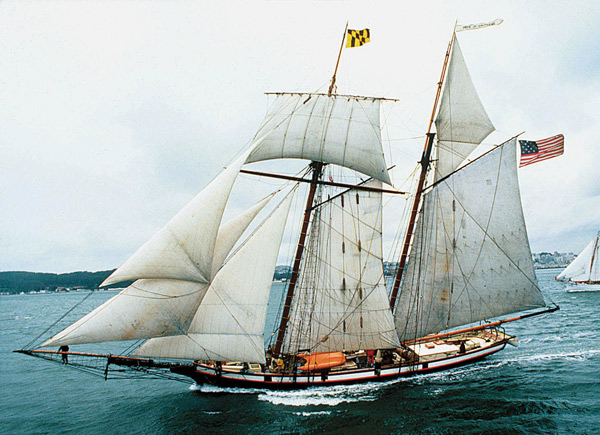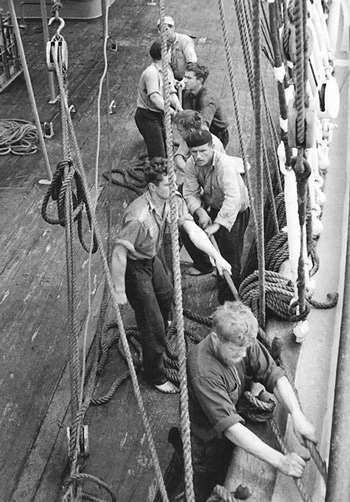Learning the Ropes
by Mike Crowe

The clipper ship Pride of Baltimore. A ships rigging looked complex, but it was orderly. Later clippers were square rigged and had more complex rigging. Every rope had a function, name and place, and every able seaman knew all of them. What appears a maze of ropes had been contrived over centuries. Photo by Greg Pease
The square-rigged ship, with square sails stacked along masts amid a dense web of ropes, brings up different images. To some people it’s a vessel from the distant past, to others a cumbersome vessel that only sailed before the wind.
Today, referred to as tall ships, the rigging and handling are incomprehensible to some. However, the square rigger was commercially sailed well into the 20th century. Like most sailing vessels it ran best before the wind, but captains could and would have argued that it was a versatile and effective rig. The rigging looked complex, but it was orderly and in that context comprehensible.
Every rope had a function, name and place and every able seaman knew all of them. What appears a maze had in fact been contrived over centuries so that each part performed its function without getting in the way of the others. Standing rigging stood, supporting the masts. Running rigging controlled the movement of the sails and yards. These ships were rigged with literally miles of rope. There were dozens of different knots commonly used, many specific to a rope’s particular function. There were buntlines across the full sail, lines to tie an unfurled sail to a yard, stirrups to hold a footrope, lines to haul up a yard — (the halyard), downhauls, reef tackle lines, clew lines, sail leech lines, tail ropes, barely the beginning of a long list. The list of knots used was equally long.
Apprentice seamen were learning the ropes. No man was rated “able seaman” until he satisfied a committee of his peers that he was thoroughly competent and experienced. More than his own life may depend on it. The men who went to sea as professional seamen on the whole took great pride in their competence. The square-rigged ship was a tough, exacting taskmaster and never bore fools gladly.
There were various categories of squarze-rigged ships defined by the number of masts, sails and their configuration. When steel ships with steel masts and yards appeared in the late 19th century, they carried six sails per mast, three sails were hauled up and three hauled down. The largest was the 5-masted Preussen built in 1910. Prior to steel ships there were typically four sails per mast. From the bottom up they were the course, topsail, top-gallant and royal. The steel ships also had a lower topsail and a lower top-gallant.

Hand me that line! Aboard the square-rigged ship there were miles of rope. Every one had a function, name and place. Order was a high priority. a particular rope was secured with a specific knot. The ropes were the gears, valves, and regulators of the square-rigged ship. Apprentice seamen had to learn all of them.Photo from Learning The Ropes: An Apprentice On The Last Of The Windjammers by Eric Newby, 1999 courtesy of John Murray (Publishers) Ltd.
Perpendicular to the mast were yards that the sails were “stretched” from. Sails were brought aloft once at the beginning of a voyage. Only after sails were properly hauled aloft did sailors climb into the rigging. Steadily, but swiftly they went up ladder like “ratlines” in the standing rigging on the weather side, climbing over the junction of the lower and topmast, then the topgallant or the royal mast at the top.
Reaching the yard they jumped down to the footrope below the yard which functioned as a work platform. The sail was attached, drawn out to the end of the yard or yardarm and unfurled. Lines ran from the lower corners of the sail, and from the ends of the yard to the deck. These lines, the sheets and braces respectively, were used to set and change the angle of the sails by sailors on deck hauling on the lines.
There was a lot of adjusting or bracing of the sails once underway. The yards were braced to adjust for a wind shift, course change or wind and sea conditions. This was strenuous work, particularly when the ship was near or before the wind. Braces would then have to be hauled against the force of the wind in those cases. It was also dangerous since it was done in all kinds of weather and crewmen were often washed away.
Six or more men may be needed on a single brace, another group on the sheet and two groups on the other rail. Keeping the ship moving was the basic strategy. Sails were tweaked in light airs and in gales to maximize speed. Maximizing speed could be less important than saving a sail or rigging, and for this, crewmen were called into what was hazardous duty by any standard.
Working 200 feet up, in the dark, on ice-coated footing, with winds howling through the rigging, in driving snow or rain while atop a mast whipping back and forth as the ship rolled, was expected of sailors. They were regularly sent to struggle with the canvas and secure it in the wildest seas.
The worse the conditions the more important it was that they accomplish what they set out to do. The danger of being in the rigging in practically any weather was clear. Falling to the deck from great heights, bouncing off a lower yard on the way or being pitched from a yardarm into turbulent seas in the dark, can be easily imagined. But the greater danger was on deck with a sea on. A wall of water coming over the side could throw a crewman against any one or more of the pieces of heavy equipment that crowded the deck before washing him overboard.

“Sailors went aloft in all kinds of weather. The more severe the weather, the more important it was that they do what they set out to do. Here four hands are securing a section of the foresail which has come loose from the gaskets in heavy weather. The men are on a lower yardarm of the steel barque Garthsnaid, built in 1882. There were five yards and sails above this one on the fore mast.” Photo from Sails Last Century: The Merchant Sailing Ship 1830-1930, courtesy of Conway Marine Press Ltd. 1993.
However, the most dreaded location was out on the bowsprit taking in a topgallant jib in heavy seas. A 30-foot bowsprit with four hands on it, no safety net and only a footrope to stand on, could plunge deep into a swell and come out the other side without a trace of the men. This no doubt sounds like what some people may see as an occupation from hell, but many sailors and captains looked forward to heavy weather. The ship sailed faster, it was definitely more exciting and for men who may have been on ships since childhood it was an opportunity to “show their stuff” and work as a team.
Some knew no other life and many would choose no other life. Although the pay was usually bad and they were as likely as not to blow it all at the first landfall, many found more security in the fraternity of the sea. When known from an early age, life at sea may have been, by comparison, easier to understand.
Many kinds of men and boys came to work on ships. The range might include the boy from a family that already had too many mouths to feed, the young man from a prosperous family with an interest in life at sea and the man on the run who sought a few years on the other side of the earth.
There were many more ships then. Before railroads, more went by sea and several ships were needed to take what one container ship carries today. It was a time when ports were jammed with all kinds of ships, few child labor laws and a lot more sailors.
The merchant marine was a major employer in the world economy of the 19th century. The work and life of the sailor was visible. Life aboard ship in those days has been likened to life in a monastery. While religion was pretty clearly not part of the comparison, the self-sufficiency of the ship, isolation, the unique life sailors led, hierarchy, order and brotherhood could be said to be similar. Being regularly called into life-threatening situations and losing brothers to them, as well as carousing with other drunken sailors ashore, had, on the other hand, no parallel in the monastery.
Structure and order were important and necessary aspects of operating sailing ships. Most ships of similar type, full-rigged ships, brigs, etc., were rigged the same way. An “able seaman” could go from one full-rigged ship to another and find all the ropes in the same place. Captains were typically conservative and resistant to change. Their orders were the same on all ships and all seamen knew exactly what they meant. There was no drill, it would have been an insult to the crewman’s sense of competence. The complex engines that replaced the sails, were probably less complex in total than all the rigging and the experience of the crewmen.
Changing course in a square-rigged ship was more complicated than on a schooner, where the sails were rigged parallel with the keel. The schooner sail had a single line or sheet from the boom of each sail. The square rigger had four lines to each sail, a sheet at each lower corner and a brace at each end of the yard.
Tacking was done by sailing into the wind with yards at a steep angle to the centerline of the hull, the bow was brought across the oncoming wind. Sails were now filled from the forward side “aback.” The main and mizzen sails were then rapidly hauled around and began to fill on the new tack. The fore sails were left to push the bow of the ship around to a point where they too were shifted around. Bringing all these yards and sails around involved a lot of ropes and was done quickly.
Sailing a square rigger backwards was a maneuver few other rigs could manage. With the wind and tide favorable, a ship could be brought around into the wind before an estuary. With the tide coming and the foresail yards aback, the ship could be backed up a river too narrow to turn around in when leaving. The same maneuver was used after dropping anchor to set it at an anchorage. Approaching an anchorage, sails are rapidly shortened. The bow is brought into the wind, the anchors let go and with the remaining main topsail aback moves the ship back setting the anchor.
